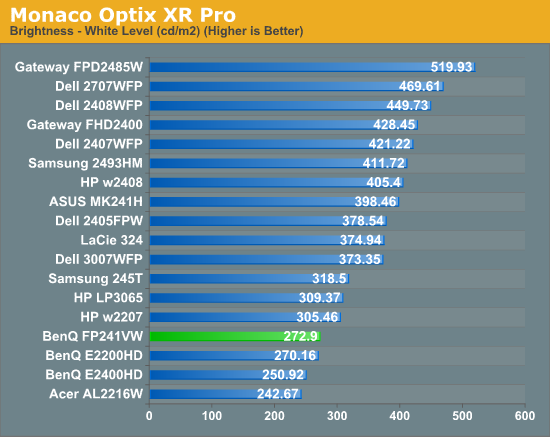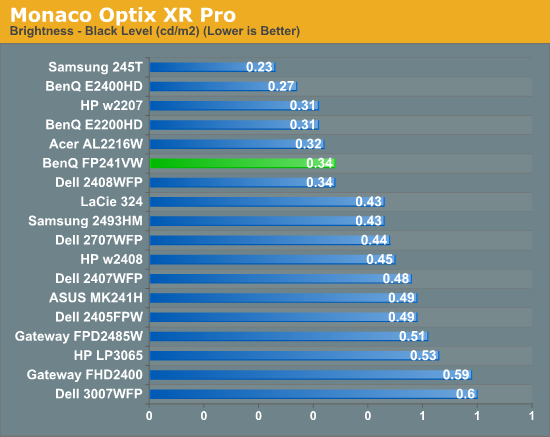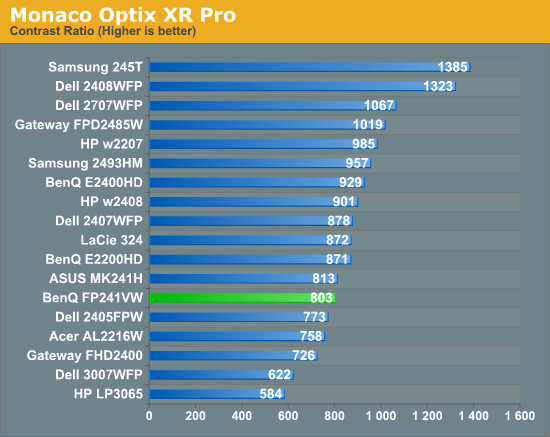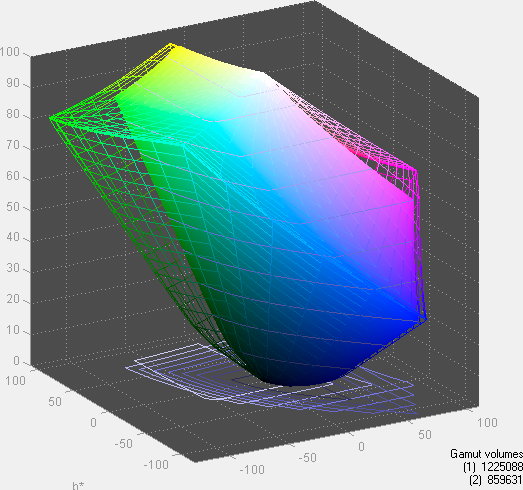Brightness and Contrast Ratio
For the brightness, contrast, and color accuracy tests, we depend on a hardware colorimeter and software to help calibrate the displays. We use a Monaco Optix XR (DTP-94) colorimeter and Monaco Optix XR Pro software, and we also test with ColorEyes Display Pro. Results in nearly every case have been better with Monaco Optix XR Pro, so for this article we're skipping the ColorEyes Display Pro results. We didn't perform a complete evaluation of the FP241VW, so we're missing maximum/minimum brightness results, but in general the display performs similarly to other LCDs.



Don't pay too much attention to the white/black graphs, as they are merely reference points for how the displays perform at certain settings. Like many other LCDs, the FP241VW has a "normal" brightness level of ~270 nits, which is more than sufficient and is actually brighter than what most users prefer to use in an office environment. You can reach the advertised 500 nits brightness if you adjust contrast and color levels as well. More important than brightness levels is the contrast ratio at the various settings. We measured a contrast ratio of 800:1 with the FP241VW, which is a decent result placing it in the lower mid section of our charts. While higher scores are better, in reality anything above 500 is sufficient for most users (i.e. the HP LP3065 that we like is at the bottom of the chart). Also, we wouldn't worry about any advertised dynamic contrast ratio numbers - at least not if you want consistent colors.
Color Gamut
Below is a comparison of color gamut for the LCDs we've tested. We use Gamutvision, a utility developed by Imatest LLC, to calculate color gamut. We compare the color profiles of the LCDs to the Adobe RGB 1998 color profile and report the results as a percentage - higher being better.


So far, color gamut has generally fallen into one of two categories: either +/-95% or +/-75%. Color gamut is determined almost exclusively by the backlighting, and the BenQ FP241VW falls short of other high-end LCDs in this area. In fact, it's at the bottom of the chart (though the difference between 70% and 75% isn't something you're likely to notice, so the bottom grouping essentially is a tie). For the original price, we would expect better, and if AU Optronics updates this particular panel we would definitely like to see a better backlight. Ideally, what we would like to see from more manufacturers is the use of LED backlighting - you can get extremely high color gamuts using RGB LEDs, and power requirements are also lower than traditional CCFL backlights. It's important to keep things in perspective, however: 70% may seem very low, but if you are using the standard sRGB profile (Windows' default) these LCDs look fine. It's only in applications like Adobe Photoshop with its expanded color space that you might notice a difference between the display color gamuts.










114 Comments
View All Comments
tomoyo - Wednesday, June 17, 2009 - link
AUO seems to have focused on using AMVA and AMVA3 (their latest tech) only on LCD TVs. The only way to get their good stuff is to buy a 32" 1080p LCD TV using their panel. If you look at their current monitor production, it's literally ALL tn-film. Depressing to the extreme.http://auo.com/auoDEV/products.php?sec=monitor&...">http://auo.com/auoDEV/products.php?sec=...mp;func=...
JarredWalton - Wednesday, June 17, 2009 - link
And the worst part is that the page starts out by talking about how great AMVA is... and then they only have TN panels listed. Ugh....tomoyo - Wednesday, June 17, 2009 - link
Going by B5 analogies. Looks like E-IPS is now our last best hope for good LCD panels. S-PVA would interest me more if there was less input lag, but E-IPS seems to have a good chance of giving us good viewing angles + decent panel speed. Now if we could only get LED backlights + 120hz + ergonomic stands in a 16:10 format over a wide variety of sizes, then we'd be in business. I can't imagine that some company out there wouldn't see an opportunity for premium lcd monitors that hardcore gamers/photography/graphics lovers would love to have at moderate prices. I think this area is a completely unrealized market opportunity.I also really dislike the 16:9 format for LCD monitors. It's takes away the balance between fullscreen and widescreen that we have with 16:10. Another cost cutting move that annoys me greatly.
darklight0tr - Wednesday, June 17, 2009 - link
LED backlights on computer LCDs seem to be a very low priority for manufacturers right now. The focus for that tech seems to be LCD TVs, which is disappointing. I'm beginning to think we'll see OLED computer displays before LED backlight LCDs at the rate they're going! The other problem with the LED backlighting is many manufacturers have been pairing it with TN panels. Its like putting a V8 into an econobox.E-IPS looks to be very good, but one of the reasons I went with S-PVA despite the display lag possibility is contrast is a weak point for IPS technology, and that was an important feature to me. Plus, it wasn't widely available in the screen size I was looking for.
If they make 120hz PC LCDs available, I want it to be TRUE 120hz, not the crap they've been selling with LCD TVs. I've seen "120hz" TVs and its obvious that it is an image processing technology that emulates 120hz, and it looks like crap. My friend has it on his TV, and I had to make him turn it off because it was so distracting.
erple2 - Monday, June 22, 2009 - link
To be fair, the bulk of the 120Hz technologies in TV's (particularly flat panel sets) exists solely for de-judder purposes. It conveniently lets you display 24 fps, 30 fps, and 60 fps content at an even multiple.My Sony TV is a 120 Hz TV - I think that there are 2 things that it's used for:
1. "Motion Smoothing" - very cool but super-annoying technology that smooths out and essentially interpolates intermediate frames in slower than 120Hz content. It's somewhat distracting with film - you can think of it as watching a movie, but filmed with a modern high end digital video camera. The "action" is interpolated to appear more than 24 Frames per second. I don't like it.
2. Solid de-juddering. Since most TV's are 60 Hz, when showing content that isn't an exact multiple of 60, the TV has to do some pulldown to get the image to appear right on the TV (the so-called 3:2 pulldown). The 120 Hz "fixes" that, since you don't need to do any complicated pulldown algorithms to get the proper effect.
Since there is no 120 Hz content available that you'd normally watch on a TV (games displayed from a very high-performance computer being the only exception I can think of), I think that it's mostly a marketing talking point.
So, no, generally, the 120 Hz TV's are actually 120 Hz TV's - they do update the display ever 1/120th of a second. However, given LCD's inability to fully RENDER a new pixel that fast is a whole 'nuther issue. 120 Hz translates to 8.333 ms response time necessary to actually change the image on screen.
darklight0tr - Wednesday, June 17, 2009 - link
On top of all that there has been a disturbing move to 16:9 displays. I know they are trying to standardize things, but I really like the extra real estate offered by 16:10. I guess I'm going to have to keep my DELL 2709W until something amazing comes along or it explodes.hyc - Thursday, June 18, 2009 - link
Second that. I want a 42" 1920x1200 monitor to replace my living room TV, but no such beast exists, they're all 1920x1080. Talk about frustrating.The interesting thing about "voting with your wallet" is you can only vote from a selection of what the manufacturers offer you, there's no way to vote for a new product that none of them currently offer. These days, my wallet has been staying closed...
tomoyo - Wednesday, June 17, 2009 - link
The market for LCDS has been terrible for over a year now. Basically all the high quality non-tn films have been discontinued with a few rare exceptions. Also all the high quality height adjustable stands are mostly gone, which makes it almost impossible to put lcds in a position that doesn't cause back/neck/carpel tunnel/etc issues. It's idiotic what we have these days.I'm lucky I have two older dell models that are non-tn film at work and a similar one at home, all with adjustable stands. 1905FP and 2001FP to the rescue. Sadly I can't even imagine changing these out for any new model, because in general the new models are WORSE. I consider myself stuck with these models until a miracle happens.
Now for a secondary screen, generally the best solution I've found for a good panel is to get a 32" LCD TV 1080P. That's one of the only ways to get a moderately usable screen at a low price, which also has FAR more inputs than any Lcd monitor. You can't get $600 Lcd Monitors that are 32" with 3-4 hdmi inputs and massive amounts of composite/component/s-video. The only huge negative is the low resolution, but 1080P is certainly liveable and great as a secondary video watching device.
BugblatterIII - Wednesday, June 17, 2009 - link
I've got a Dell 2407WFP but that's being reallocated so I'm planning to get the Dell 2407WFP. H-IPS screen, portrait rotation, fantastic quality, low latency etcBugblatterIII - Wednesday, June 17, 2009 - link
Of course I meant planning to get the HP LP2475w.